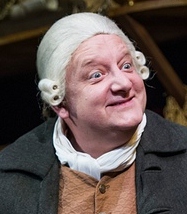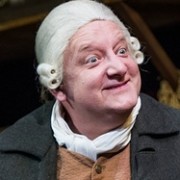PJC WEBSITE REVIEW/8 – MR FOOTE’S OTHER LEG WRITTEN BY: IAN KELLY
DIRECTED BY: RICHARD EYRE
PERFORMED AT: THEATRE ROYAL HAYMARKET
STARRING: SIMON RUSSELL BEALE
Review of play seen on 30 December 2015
If in the early twentieth century Sarah Bernhardt in her 70s could move audiences to tears, whilst wearing a wooden prosthetic leg,1 why could not Samuel Foote in his 50s stir eighteenth-century audiences to laughter, wearing a similar appendage? The answer was that he could – and did. But it takes an actor of fine ability to make today’s audiences both sympathise with his painful disability and laugh at his wit and antic comportment. Simon Russell Beale manages the task with a truly bravura display. If upon other occasions his performances can seem too fidgety (in my view), this time he is in his element. His repeated grin alone would win him acting prizes – as he sets his mouth in a laughing grimace that is at once innocent but knowing, cheerful but melancholic, loveable but menacing, spontaneous but somehow pre-ordained.

|
Simon Russell Beale as Mr Foote |
The play itself is not without problems. It has been developed into a stage version by Ian Kelly, who also acts the part of George III, from his earlier book on Samuel Foote (published in 2013).2 That textured study looked closely at the acting history and social context of the Georgian theatre. It did not demand a tremendously dramatic plot, other than the unfolding of Samuel Foote’s career as an actor-director-dramatist. The big crisis of his life was indeed the amputation of his gangrenous left leg, which is enacted with suitably squirming relish at the end of Act 1. But as Mr Foote rhetorically demands, while the curtain falls, what an earth is left to happen in Act 2?
What follows is episodic, in the style of Act 1, but in a much more melancholic vein. In real life, Samuel Foote became increasingly unpredictable in his later years, quite possibly as a result of head injuries sustained in the accident which cost him his leg. A series of vignettes show him as demanding, fretful, and isolated, as well as thwarted in his passion for his Jamaican theatre-dresser, whilst continuing to present Foote’s comic persona on stage – witty, scabrous, dressed in drag, and twice as large as life. It’s a well-known trope about comic actors and entertainers, who make audiences laugh while their own hearts are, if not quite breaking, then bruised and sombre. On with motley!
However, the point of this play is not to uncover fresh secrets about the art of comic acting but to celebrate its sheer ludic power. That opportunity drew eighteenth-century audiences to see Mr Foote; and twenty-first-century audiences should hasten to see Simon Russell Beale for the same reason. It should be noted too that the direction by Richard Eyre is splendid; the stage-sets are inventive and generate a dynamic framework for the succession of short scenes; the script is witty (complete with lots of jokes about feet); and the ensemble acting is outstanding.
For eighteenth-century experts, there is the additional fun of seeing real-life historical personalities – such as David Garrick [Joseph Millson], Peg Woffington [Dervla Kirwan], Francis Barber [Micah Balfour] – portrayed on stage with invented dialogue which allows the actors to bring them to life, complete with individual idiosyncrasies. It is not ‘real’ history but it does encourage historical empathy. The moment when the dark-skinned Jamaican Francis Barber comes face-to-face with two actors, both blacked-up and bewigged in the part of Othello, is funny but simultaneously challenging to fresh thought about historic acting conventions. (By the way, Foote’s employment of Francis Barber, the trusted factotum of Dr Johnson, is a flight of fancy from Ian Kelly). Nonetheless, while this play is structurally somewhat meandering and thematically incongruous, it offers a feast of theatricality and musings on the art of theatre. The wooden leg of Simon Russell Beale’s Mr Foote can walk tall alongside the legendary limb of Sarah Bernhardt.
1 Reports differ as to whether she actually wore such a limb after her amputation.
2 I. Kelly, Mr Foote’s Other Leg: Comedy, Tragedy and Murder in Georgian London (2013).
To read other reviews, please click here.

